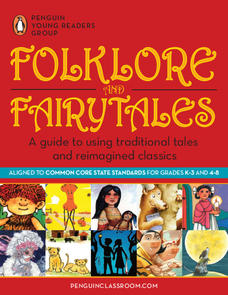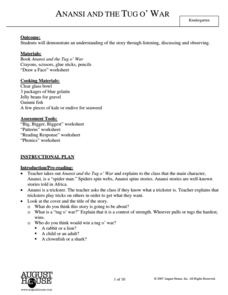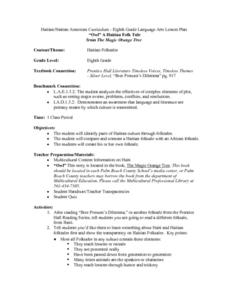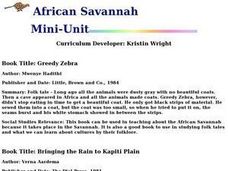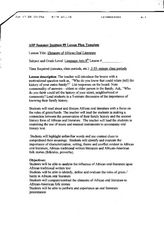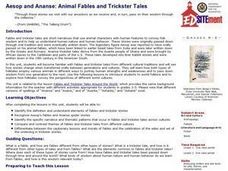Curated OER
Different Strokes For Different Folktales
Young readers use graphic organizers, such as Venn diagrams and story maps, to analyze a variety of folktales and the elements of a story. They use writing, sequencing activities, and creative art to identify the morals learned from a...
Penguin Books
Folklore and Fairytales: A Guide to Using Traditional Tales and Reimagined Classics
Every culture has its own stories to tell. An interesting educator's guide shares a large collection of fairytales and folktales, some from different cultures and some re-creations of classics. A summary and brief teaching ideas...
Curated OER
Comparing African, American, and European Folktales
Students find compare an African, Native American, and European folktale. In this folktale lesson, students listen to three different folktales before finding the similarities and differences in them. They complete a worksheet of...
Curated OER
Cinderella in Africa
Explore African folk tales! After reading the African folk tale "Mufaro's Beautiful daughters" and the American version of "Cinderella," youngsters list differences and similarities between the two. Draw a T-chart on the board, and hold...
August House
Anansi and the Tug o' War
Combine art, math, language arts, drama, and delicious Jell-o with a instructional activity based on the African folktale Anansi and the Tug o' War. Kids make predictions and discuss plot points of the story before joining in...
Curated OER
Our Side of the Story: African Americans Share Their Experiences of Slavery
Seventh graders listen to a variety of folktales sharing experiences of slavery. As a class, they compare and contrast reading a story and telling a story. They participate in a role play activity to discover the journey of a slave and...
August House
The Clever Monkey Rides Again
Use a West African folktale to practice several different skills in your first grade classroom. Learners read The Clever Monkey Rides Again and focus on rhyming words, reading comprehension, measurement, art, movement, and word...
National Endowment for the Humanities
Folklore in Zora Neale Hurston's Their Eyes Were Watching God
Learners define folklore, folk groups, tradition, and oral narrative. They identify traditional elements in Their Eyes Were Watching God Analyze and understand the role of traditional folkways and folk speech in the overall literary...
National Endowment for the Humanities
A “New English” in Chinua Achebe’s “Things Fall Apart”: A Common Core Exemplar
To examine the “New English” Chinua Achebe uses in Things Fall Apart, readers complete a series of worksheets that ask them to examine similes, proverbs, and African folktales contained in the novel. Individuals explain the meaning...
Curated OER
"Owl" A Haitian Folk Tale
Eighth graders read and discuss the Haitian folktale, "Owl." They compare it to the story, "Brer Possum's Dilemma," using a Venn diagram to show how they are different and alike. In groups, they retell the story in a skit format.
Curated OER
Comparing African, American, and European Folktales
Students listen to John Steptoe's story, "Mufaro's Beautiful Daughters," and then identify similarities and differences between an African, a Native American, and a European folktale.
August House
Anansi Goes to Lunch - Kindergarten
Greed is the theme of the West African folktale, Anansi Goes to Lunch and this multidisciplinary collection of lessons. First, scholars listen to a read aloud and participate in a grand conversation about the book's key details and...
Curated OER
Haitian Folktales
Seventh graders identify parts of Haitian culture through folktales. They compare and contrast a Haitian folktale with an African American folktale. They read "Bye-Bye" a Haitian folktale. They create and write their own folktale. They...
Curated OER
African-American Folktales
Students are introduced to the characteristics of folktales and their purpose. As a class, they listen to a folktale, answer questions about the characters and share which part they enjoyed the best. In groups, they compare and...
Curated OER
Her stories: African American folktales, fairy tales, and true tales
Students discuss the illustration's allusion to the myth, Pandora's Box. Students locate instances of folk sayings or expressions that make these tales seem authentic to the reader. Students draw a Venn diagram comparing Catskinella and...
Curated OER
African American Traditions: Cameroonian and African-American Folktales
Students compare Cameroonian and African-American folktales. In this folktales activity, students participate in a jigsaw activity that requires them to read "The Owl Never Sleeps as Night," "Why the Lizard Often Nods," "Tappin, the Land...
Curated OER
Stories Share Similar Scenes
Students listen to similar stories that come from different cultures and compare them. In this folktale lesson plan, students focus on different versions of "Cinderella," then complete a worksheet which is embedded in the plan about two...
Curated OER
Folktales (African American, Chinese, Japanese and Korean)
Young scholars participate in a variety of activities that are concerned with comparing different cultures through the literary genre of folktales. The stories are used to stimulate student interest and provide a context for how a...
Curated OER
African Savannah
Students are read two African fairy tales. Using the text, they create a map and key for each region mentioned. They compare and contrast the various communities and discover how geographic features affect how people live.
Curated OER
Elements of African Oral Literature
Ninth graders examine the importance of family history. For this Language Arts lesson, 9th graders read and discuss African oral literature with a focus on the roles of griots. Students compare /contrast the elements of...
Curated OER
Aesop and Ananse: Animal Fables and Trickster Tales
Students complete compare and contrast activities dealing with fables and trickster tales to determine how each uses animals to portray human characteristics, specifically strengths and weaknesses, as well as pass wisdom from one...
Curated OER
Fables and Trickster Tales Around the World
Students analyze fables and trickster tales from various cultural traditions. In this fable analysis lesson plan, students identify the elements of fables and trickster stories. Students read Aesop's fables and Ananse spider...
Curated OER
Choose Your Path
Learners identify the plot and theme of cartoons. In groups, they discuss and compare the written and movie versions of popular fairy tales. Individually, they write their own fairy tale and share them with the class. They write their...
Curated OER
A Moroccan Fairy Tale vs. European Folk/Fairy Tale
Second graders explore world geography by reading two different fairy tales. In this cultural storytelling lesson, 2nd graders read Snow White and the Seven Dwarves and the Moroccan story The Girl Who Lived with the Gazelles. Students...



